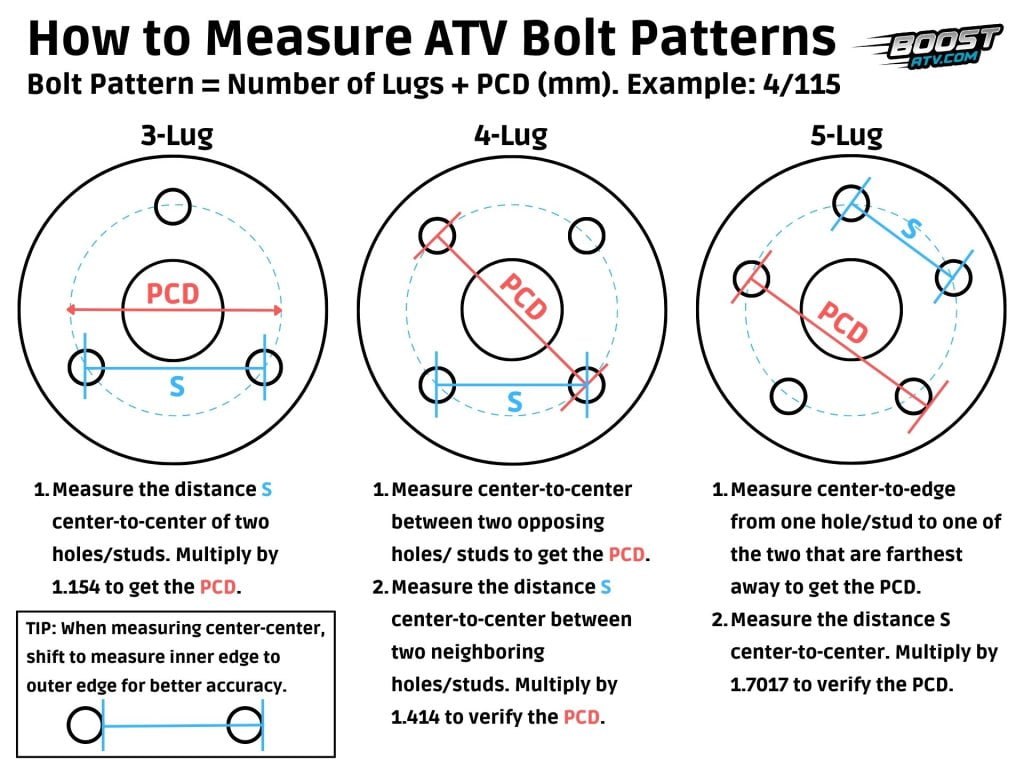Decoding Your 4-Lug Wheel Bolt Pattern: A Crucial Car Hack
Ever stared at a wheel and felt utterly clueless about its bolt pattern? You're not alone. This seemingly obscure piece of automotive knowledge is actually vital for anyone who's ever had a flat tire, considered upgrading their rims, or just wanted to feel a little more in control of their vehicle's destiny. Knowing your 4-lug wheel bolt pattern is like having a secret handshake with your car – it unlocks a world of possibilities, from finding the perfect replacement wheel to avoiding a roadside disaster. So, buckle up, because we're about to dive deep into the fascinating world of 4-lug wheel bolt patterns.
Determining your 4-lug wheel bolt pattern isn't rocket science, but it does require a little bit of know-how. Essentially, you're measuring the distance between the bolt holes that secure your wheel to the hub. This measurement is crucial because it dictates which wheels are compatible with your vehicle. Mismatched bolt patterns can lead to vibrations, loose wheels, and even catastrophic failures – definitely not something you want to experience at 70 mph. So, understanding how to measure a 4-lug bolt pattern is more than just a cool trick; it's a fundamental aspect of car ownership.
The history of wheel bolt patterns is intertwined with the evolution of the automobile itself. As cars became more sophisticated, so did their wheels and the methods for attaching them. Standardized bolt patterns emerged as a necessity for ensuring interchangeability and safety. The 4-lug pattern, often found on smaller cars and trailers, represents a balance between simplicity and strength. However, not all 4-lug patterns are created equal; variations exist, which is why accurate measurement is so crucial.
A common issue when measuring 4-lug bolt patterns is confusing the diameter with the bolt circle diameter (BCD). The diameter is simply the distance across the wheel, while the BCD is the diameter of the circle formed by the centers of the lug holes. This is the critical measurement you need to determine compatibility. Another frequent mistake is measuring from the edge of one hole to the edge of another, rather than from center to center. These seemingly small errors can lead to purchasing the wrong wheels, a costly and frustrating mistake.
So, how do you actually measure a 4-lug bolt pattern? For a 4-lug wheel, measure from the center of one lug hole directly across to the center of the opposite lug hole. This measurement is your bolt pattern. For example, a measurement of 4x100 means there are 4 lugs and the bolt circle diameter is 100mm. Simple, right? But making sure you're measuring accurately is key. A digital caliper can help ensure precision, but even a ruler can suffice if used carefully. This precise measurement is your key to finding the right replacement wheels and ensuring a safe, smooth ride.
Benefits of knowing your 4-lug bolt pattern include ensuring correct wheel fitment, avoiding potential safety hazards, and expanding your wheel upgrade options. For example, if you know your bolt pattern is 4x100, you can confidently shop for aftermarket wheels knowing they will fit correctly.
Step-by-step guide: 1. Clean the mounting surface of the wheel. 2. Measure from the center of one lug hole to the center of the opposite lug hole. 3. Record the measurement in millimeters.
Advantages and Disadvantages of Measuring Your Own Bolt Pattern
| Advantages | Disadvantages |
|---|---|
| Saves time and money potentially | Potential for inaccurate measurement |
Best Practice: Use a digital caliper for accurate measurements.
Real Example: A common 4-lug pattern is 4x100, found on many small cars.
Challenge: Difficulty measuring accurately. Solution: Use a digital caliper or consult a professional.
FAQ: What is a bolt pattern? Answer: The arrangement and spacing of the lug holes on a wheel.
Tip: Double-check your measurements to ensure accuracy.
In conclusion, knowing how to measure a 4-lug wheel bolt pattern is an essential skill for any car owner. It empowers you to make informed decisions about wheel replacements and upgrades, ensures your safety on the road, and prevents costly mistakes. By understanding the importance of accurate measurement and following the simple steps outlined above, you can take control of your vehicle's well-being and enjoy a smoother, safer ride. Don't let a flat tire or a desire for new rims catch you off guard. Equip yourself with the knowledge of your 4-lug bolt pattern, and hit the road with confidence. Now, go forth and measure!
Navigating medicare understanding humana gold ppo options
Island boys legal troubles examining the assault allegations
Decoding the f150 5 lug bolt pattern everything you need to know












